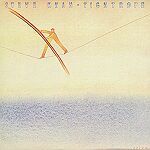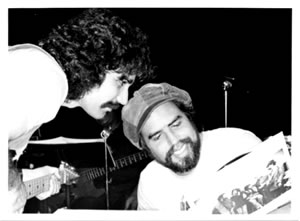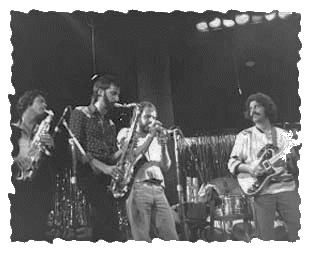 This becomes the first lead sheet/mini-score we've shared with you
from the 'old days,' from the '70s! It's the
title track from my first recording as a leader for Columbia,
"TIGHTROPE,"; which was recorded during late March-early April of 1977 at Mediasound in New York City. During those
years, I used to refer to Studio 'A' at Mediasound as "God's guitar room"
because the studio itself was a converted church with lots of wood and very,
very high ceilings. For me, it was the most wonderful room to record my guitar.
Through an amazing set of coincidences and circumstance, luck perhaps, I had
been signed to Columbia by Bob James with the not-so-gentle nudging of
Bobby Colomby. I remain forever grateful to them both for having afforded
me this most wonderful of opportunities.
This becomes the first lead sheet/mini-score we've shared with you
from the 'old days,' from the '70s! It's the
title track from my first recording as a leader for Columbia,
"TIGHTROPE,"; which was recorded during late March-early April of 1977 at Mediasound in New York City. During those
years, I used to refer to Studio 'A' at Mediasound as "God's guitar room"
because the studio itself was a converted church with lots of wood and very,
very high ceilings. For me, it was the most wonderful room to record my guitar.
Through an amazing set of coincidences and circumstance, luck perhaps, I had
been signed to Columbia by Bob James with the not-so-gentle nudging of
Bobby Colomby. I remain forever grateful to them both for having afforded
me this most wonderful of opportunities.
Not too long before, I
had parted company with the Brecker Bros. Band, for a number of reasons,
and could have only hoped to have been able to finally record as a leader.
During those years, actually throughout most of the '70s, I was very proud to have been associated with
the music of Randy & Michael
Brecker and they, along with all the core members of that group:
David Sanborn; Don Grolnick; and Will Lee all had a
tremendous influence on my musical tastes, and growth as a person. At the time,
I truly believed that we were involved in making some of the best music coming
out of New York. Though I have said this in other pages at the site, there can
be no doubt that the music I wrote and performed on my three recordings for
Columbia: "TIGHTROPE";('77); "THE
BLUE MAN"('78); and "ARROWS"('79) was an attempt to keep the Brecker Bros. Band
together as I heard it, but with a little more focus on the guitar. The
influence of that band, and especially of Randy's compositions and writing style
can be no more apparent than on tunes like "Tightrope" which feature the band's
mini-horn section.
Initially, it was my hope that "Tightrope"
would become the 'signature' piece of this album and that it would open the
recording as well. However, for better or worse, that was not to be the case.
Though by the time I entered the studio to record this music I had had a great
deal of experience as a musician, and even as a producer in the studios, I still
had a great deal to learn. As always, I tried to sit back, and watch and learn
from everyone else while not being afraid to ask for what I wanted or to voice
my opinion. During this recording, I learned a great deal, and on all levels.
Tools which would serve me well for all the years to follow.
To be
perfectly honest, I rarely listen to any of the Columbia recordings because I
now feel so disconnected from this style of writing, and the playing as well.
After reviewing my original lead sheet/mini-score to "Tightrope"  and
following along with the recording, I realized that we had obviously made some
changes, and for the better, during the actual recording. I am certain that Bob
and the rest of the rhythm section, which included another dear friend,
Steve Gadd, all made helpful suggestions involving the form and
structure. After listening to the performance a couple of times, I decided that
it would be best to just re-write the lead sheet to conform with what you now
hear. Sometimes a producer's greatest contributions can be in hearing excess and
making suggestions which 'trim the fat' as it were. In that regard alone, I
learned a great deal from Bob James about how to listen to what you are
recording, and to try to be objective when faced with decisions about the music.
I suppose were this piece to be performed live, I would 'open-up' letter
[I2] a bit more for the rhythm section to flex its muscles, and there
certainly would have been at least one more solo. And. without question, I would
have fought to have found a way to reprise [A] before the tune ends.
and
following along with the recording, I realized that we had obviously made some
changes, and for the better, during the actual recording. I am certain that Bob
and the rest of the rhythm section, which included another dear friend,
Steve Gadd, all made helpful suggestions involving the form and
structure. After listening to the performance a couple of times, I decided that
it would be best to just re-write the lead sheet to conform with what you now
hear. Sometimes a producer's greatest contributions can be in hearing excess and
making suggestions which 'trim the fat' as it were. In that regard alone, I
learned a great deal from Bob James about how to listen to what you are
recording, and to try to be objective when faced with decisions about the music.
I suppose were this piece to be performed live, I would 'open-up' letter
[I2] a bit more for the rhythm section to flex its muscles, and there
certainly would have been at least one more solo. And. without question, I would
have fought to have found a way to reprise [A] before the tune ends.
One thing about my composing style, which has not changed much in all these
years, is that I still write from the perspective of 'mood' and 'attitude'
first. Sometimes those qualities are born from a 'groove,' something which feels
natural to me. The basic vamp you hear at [I2] was the fundamental germ
from which this piece was created. I recall sitting and playing this 'feel' at
home and then extending it through the chord progression you now hear in letter
[A]. I guess it must have been those damn '70s, because now it's hard to imagine sitting
around the house "groovin' in 11/4!!!" Everything else came afterwards,
and probably the last thing I thought about was the solo format, [C]
which, in the end, we improvised in the studio with Bob conducting us through
the changes while I soloed live. As things worked out, the first section was
32-bars and all the changes to follow were 16-bars in length. As always, Bob
makes very musical decisions. Anyway, once the melody to [A] was
completed, the rest of the piece was constructed around it.
As I
suppose it should, the Intro, [I], serves to foreshadow many of the
elements and sounds which are to come later in the piece. The main guitar sound
hits right at the top; the harmonic style is all there, the mini-horn section is
introduced, and there's even a hint that something in 11/4 is coming if you look
at bars 6-7. Though the Fender Rhodes and, more specifically, Don Grolnick's
approach to that instrument, were pivotal to this tune, everything was composed
while at the guitar.
One of the great little 'arranging tricks' I
had learned some years earlier was from Don Costa, one of Frank
Sinatra's favorite arrangers. He explained to me that basically any guitar
voicing of 3 or 4 notes would translate perfectly when voiced for horns, and
even strings. For example. if we were to spell down from the Ab above middle-'C'
and you had this voicing in 4ths: Ab-Eb-Bb-F; and you then assigned those notes:
Ab(trumpet); Eb(alto sax); Bb(tenor sax); F(trombone) it would sound wonderful.
You could switch the colors around and the results would be the same. For
example: 2 trumpets, 2 trombones; or, 2 trumpets, 1 alto sax, 1 tenor sax; the
possibilities are endless. The same would hold true if you gave that voicing to
2 violins, 1 viola, and 1 cello. Don Costa knew all this because, he used to be
a guitarist himself!!! This kind of wisdom was invaluable to me for, in my years
at U.C.L.A.('65-'69), music degree or not, I could not get this kind
of education or training. So, with this little 'trick' in hand, I had confidence
that all my horn parts were going to work!!! Lucky for me, because it's daunting
enough to sit, with your little score in hand, in front of Randy Brecker,
Michael
Brecker, David Sanborn(who can improvise better horn parts
than most of us can arrange), to have Bob James in the booth, and to discover
that you have written something unconscionably stupid. But, that has happened to
me too, on occasion, and all you can do is to laugh at yourself and try to fix
it!!! Usually, everyone helps, if they like you! If they don't they just sit
there, stare at you, and wait to be told what to do!
 Where bass
and drums were concerned, how could one be much luckier than to have Will Lee
and Steve Gadd. Together, they made everything I wrote, which wasn't
much, over the course of three albums, sound and feel so much better. I actually
made a couple of small corrections in letter [B] to reflect what Will
played instead of what I actually wrote. Steve Gadd took this opportunity
to utilize his famous paradiddle interplay between the hi-hat and the snare to
construct an amazing drum groove for this complex meter. For those of you, who
don't follow 'drum history' too closely, the first time Steve Gadd ever
heard this 'lick' was during a Japan tour we all did(with Yoko Ono of all
people), with a band that consisted of: Randy & Michael
Brecker; Don Grolnick; Andy Muson(elec. bass); and Rick
Marotta. Yes, there were two drummers! Rick and Steve were best friends and
held great admiration for one another. On one of the bullet train rides, I
happened to play a track, "Mean Ole World," from Jerry LaCroix's LP,
"THE SECOND COMING"(Mercury). Jerry LaCroix was then well known for his
work with Edgar Winter's White Trash. This album featured Rick Marotta,
and what I knew to be as the 1st appearance of this drum 'lick.' As soon as
Steve heard it on my cassette player, he made me play that damn cassette for him
over, and over, and over again. Each time, the intensity of his dialogue with
Rick, about just how this was done, increased. Finally, after lots of banging
away on armrests and legs, Steve had it down. So, at the next soundcheck, Steve
drove Rick absolutely crazy with all the different permutations he could come up
with. Rick had truly "created a monster." Many people believe that Steve
'invented' this drum technique when they first heard it on the tune, "Dirty Old
Man" from Tom Scott's album, "NEW YORK CONNECTION," but they would
be wrong! Here you can enjoy Steve's incredible creativity in an odd meter.
Where bass
and drums were concerned, how could one be much luckier than to have Will Lee
and Steve Gadd. Together, they made everything I wrote, which wasn't
much, over the course of three albums, sound and feel so much better. I actually
made a couple of small corrections in letter [B] to reflect what Will
played instead of what I actually wrote. Steve Gadd took this opportunity
to utilize his famous paradiddle interplay between the hi-hat and the snare to
construct an amazing drum groove for this complex meter. For those of you, who
don't follow 'drum history' too closely, the first time Steve Gadd ever
heard this 'lick' was during a Japan tour we all did(with Yoko Ono of all
people), with a band that consisted of: Randy & Michael
Brecker; Don Grolnick; Andy Muson(elec. bass); and Rick
Marotta. Yes, there were two drummers! Rick and Steve were best friends and
held great admiration for one another. On one of the bullet train rides, I
happened to play a track, "Mean Ole World," from Jerry LaCroix's LP,
"THE SECOND COMING"(Mercury). Jerry LaCroix was then well known for his
work with Edgar Winter's White Trash. This album featured Rick Marotta,
and what I knew to be as the 1st appearance of this drum 'lick.' As soon as
Steve heard it on my cassette player, he made me play that damn cassette for him
over, and over, and over again. Each time, the intensity of his dialogue with
Rick, about just how this was done, increased. Finally, after lots of banging
away on armrests and legs, Steve had it down. So, at the next soundcheck, Steve
drove Rick absolutely crazy with all the different permutations he could come up
with. Rick had truly "created a monster." Many people believe that Steve
'invented' this drum technique when they first heard it on the tune, "Dirty Old
Man" from Tom Scott's album, "NEW YORK CONNECTION," but they would
be wrong! Here you can enjoy Steve's incredible creativity in an odd meter.
NOTE: Rick Marotta now tells me that Steve Gadd was
actually present at that Jerry LaCroix session; and he saw Rick play that now
very famous lick! How 'bout that?!?!?
Like most music of the
"fusion" era, the [A] melody is probably more memorable for its
repetitiveness than its singable qualities. As I sit here today, this is not a
particularly appealing attribute. The bridge, [B], serves as harmonic
release from the tension build up during [A], but it too is melodically
repetitious. Again, if that makes it 'memorable,' then perhaps it's not such an
awful thing? Structurally, [B] serves as a release from the solo as well.
If I were to attempt to perform this tune today, I would try and make more usage
of the [B] harmonic area, Db major, during the solos. Though I don't
remember much about this decision, it should also be noted that we decided to
play the solo section [C] in 4/4 instead of 11/4. Were I to do this tune
again, I think I would try to stick to the original meter.
One of
the most interesting compositional or arranging features of [B] is the
Randy Brecker-esque usage of interlocking parts. Parts which are
seemingly totally separate from one another, yet on key beats, seem to connect.
The guitar melody, horn parts, a specific keyboard part, and a bass part(which
Will Lee loosely interpreted), all work well together, while functioning
independently of one another. The influence of Randy's writing and arranging was
very hard to deny or, for that matter, shake!
So, there you have
it, after many requests, we have finally introduced a lead sheet from one of the
earlier recordings. For KHAN'S KORNER, this is just the beginning, and from this
point forward we will just skip around, in no particular order, and present
other lead sheets from the past. As always, your feedback and suggestions are
heard and greatly appreciated.

